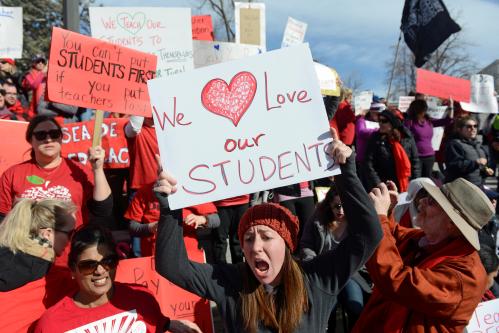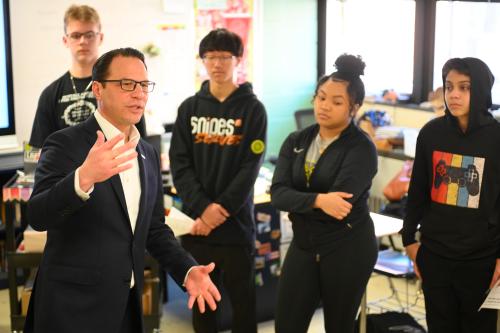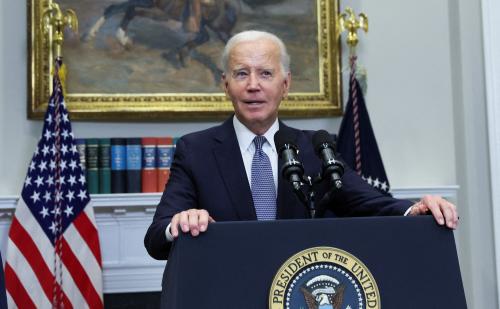This blog is part of a Brown Center series called State of the States: Gubernatorial Policy Priorities in 2023, in which Brookings experts analyze the education policy proposals outlined in governors’ 2023 State of the State addresses.
The U.S. Department of Education has two main avenues for affecting higher education policy – through administering financial aid programs and through applying accountability pressure and regulating institutions’ financial aid eligibility. The Biden administration has proposed efforts on both fronts – including the proposed student loan forgiveness program, a new income-driven repayment program, forthcoming gainful employment rules regulating career programs’ aid eligibility, and a plan to identify “low-financial-value” programs to pressure institutions to improve student outcomes.
States wield considerably more influence on public higher education institutions, with state policy levers including setting tuition, developing financial aid programs, and legislating campus activities. As part of our series analyzing the 2023 “State of the State” addresses, in this piece I examine gubernatorial and state legislative priorities for higher education policy in the year ahead and suggest how research can guide effective implementation of these proposals.
Increased, targeted investments in financial aid
Many governors outlined investments in new and existing financial aid programs – from increasing funding (such as for the existing Georgia HOPE Scholarship) to creating new scholarships (such as expanding the Arizona Promise program to DREAMers). Notably, in Michigan, Gov. Gretchen Whitmer proposed lowering the age of eligibility for Michigan Reconnect from 25 to 21—“reconnect” programs across the country typically target workers above 25 years old. By lowering the age for eligibility for this type of scholarship, this proposal will help support the cohort of high school graduates most severely impacted by the COVID-19 pandemic. In fall 2020, two-year college enrollment dropped about 10 percent nationally from the prior year. The 18-year-olds who did not immediately enroll in college are now 21 and would benefit from earlier access to “reconnect” support.
“States can and should make it easier for students to access aid.”
As states design financial aid, they should be mindful of how students access that aid. The administrative burden literature highlights the multiple challenging processes that individuals must navigate to successfully access financial aid: Individuals must learn about public benefits availability, comply with application and eligibility restrictions, bear the psychological costs of those processes as well as the challenge of redeeming the benefits they’ve been awarded. Work I have done with colleagues and that others have done in Tennessee document substantial variation in administrative burdens across state financial aid programs. States can and should make it easier for students to access aid. Already, building on a promise in Gov. Eric Holcomb’s state of the state address, the Indiana legislature is considering a bipartisan bill to reduce administrative burden in the 21st Century Scholarship Program by automatically enrolling financially eligible students. That effort provides a roadmap for other states to follow.
Closely related to shifts in financial aid is tuition – many states and colleges froze tuition in response to the COVID-19 pandemic and governors and state legislatures are considering how to adjust tuition moving forward. Several Republican governors, including those in Virginia, Utah, and South Carolina, touted continuing tuition freezes. Where governors have attempted to increase tuition, the efforts have been met with opposition. For example, Gov. Kathy Hochul proposed tuition increases at SUNY and CUNY in New York, but the effort drew public criticism, and legislative efforts opposing the increase.
Research finds that cutting tuition does not noticeably increase enrollment (and other work finds that enrollment only declines slightly in response to tuition increases). Because many colleges employ a “high cost, high aid” model where students from affluent backgrounds pay inflated rates to help subsidize money for financial aid, research suggests tuition freezes may actually harm low-income students at those schools if colleges then have to cut financial aid. The South Carolina approach of supplementing aid for Pell Grant students alongside tuition freezes has the greatest likelihood of avoiding these unintended consequences.
College and career readiness through high school experiences
Several governors called for expanded dual enrollment (DE) and career and technical education (CTE) offerings. Both academic approaches aim to bring post-high school experiences into the secondary curriculum. DE offers students the opportunity to take classes through their local community colleges (and earn transferrable college credit), and CTE provides students with specific workplace skill training (e.g., graphic design or carpentry). In Colorado, Gov. Jared Polis called for expanded DE, CTE, and work-based learning, Gov. Glenn Youngkin in Virginia called for all graduates to have earned a workforce credential while in high school, and in Ohio Gov. Mike DeWine proposed capital improvement investments in CTE centers and equipment.
About 77% of high school students take at least one CTE credit. CTE programs can have large impacts on students’ educational attainment – one analysis of Connecticut CTE standalone high schools found male CTE students were 10 percentage points more likely to graduate high school – though policymakers should be cautious about the limited evidence for the potential impact of a single CTE course relative to a more robust body of research on students who take multiple CTE courses focused on a common curriculum track.
Dual enrollment represents a large share of the community college population – 15% of first-time community college students are DE students. A review of DE student pathways shows most DE students go on to enroll in college immediately after high school, and about half of former-DE students enroll at a community college (with 84% of those students enrolling at the community college they completed their DE courses with). Research also suggests that DE students are more likely to enroll in and graduate from college than their non-DE peers.
One of the main barriers to DE participation is the cost of enrollment for students, especially since DE students are not generally eligible for federal financial aid. State funding policies affect who takes DE courses. While there are concerning racial and socioeconomic gaps in DE participation nationally, racial gaps in DE participation shrink considerably when states or local agencies cover the costs of DE tuition. Dual enrollment can often also be costly for community colleges to offer, but research suggests DE can be more cost-effective for institutions as it scales, if there are clear on-ramps to enrollment at the community college, and if DE outcomes are incorporated in to state performance-based funding systems.
Beyond the State of the States – legislative trends in state governance of higher education
While not high enough priorities to make the State of the State addresses, two trends have emerged in gubernatorial and state legislative efforts that are unlikely to have discernable positive effects on student outcomes. First, several states and university systems have banned TikTok on college campuses. As my Brookings colleagues note, there are legitimate national security concerns with TikTok and other social media platforms, but these types of bans alone are unlikely to meaningfully improve consumer safety (to say nothing of college students’ savvy circumventing these regulations).
“There is no evidence that concealed carry reduces the likelihood of gun violence, and experts warn access to guns on campus may instead increase suicide rates, the leading non-accidental cause of death among college students.”
Second, in the wake of deadly shootings at the University of Virginia and Michigan State University this academic year, some states legislatures are nevertheless advancing bills to expand campus gun access, with Tennessee proposing a bill allowing concealed carry on campus, Kentucky banning “gun free zones” on college campuses, and West Virginia signing legislation to allow campus concealed carry, despite opposition from higher education leaders. There is no evidence that concealed carry reduces the likelihood of gun violence, and experts warn access to guns on campus may instead increase suicide rates, the leading non-accidental cause of death among college students.
Threats to academic freedom
Finally, no analysis of state higher education policymaking is complete without acknowledging the wave of censorship bills introduced by Republican legislators in at least 17 states that restrict what professors can teach and how students should learn. In Florida, Gov. Ron DeSantis laid out his higher education priorities in his State of the State address and in Florida House Bill 999 which proposes wide sweeping limits and restrictions on faculty hiring, which majors or minors Florida institutions may offer, and what programs or campus activities a campus can support. The limits on course content and offerings, particularly proposed restrictions on “any programs that … espouse diversity, equity, and inclusion,” are a threat to academic freedom, even democracy itself. Higher education serves many purposes – to train individuals for careers and to advance civic knowledge, but also to foster debate and hard conversations. These partisan efforts to censor viewpoints and impose gag orders on scholars’ academic expertise should be taken seriously and vigorously opposed.
“States will also have an essential role to play in a national push to reform higher education finance and affordability as they set tuition levels and implement college accountability.”
Summary
Governors’ priorities for higher education in 2023 reflect an eye toward increasing affordability, building clearer high school-to-college pathways, and ensuring individuals have postsecondary opportunities that align with their workforce goals. States will also have an essential role to play in a national push to reform higher education finance and affordability as they set tuition levels and implement college accountability. Governors should focus on the challenging but important business of supporting lifelong learners and building a robust labor force, and not on politics-driven efforts – such as censoring college curricula – that actively work against those aims.






Commentary
State of the States: Governors and postsecondary policy
April 6, 2023